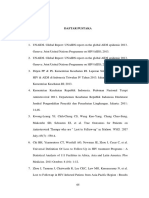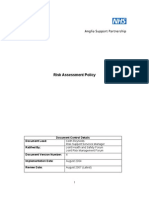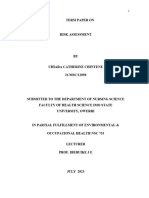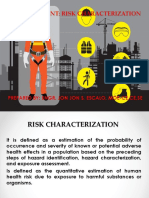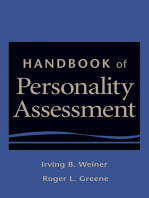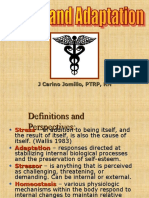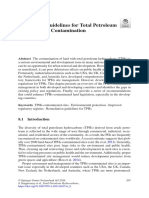Procedures For Assessment of Risk in Research Proposals WP-RES-03
Procedures For Assessment of Risk in Research Proposals WP-RES-03
Uploaded by
Khenn NealegaCopyright:
Available Formats
Procedures For Assessment of Risk in Research Proposals WP-RES-03
Procedures For Assessment of Risk in Research Proposals WP-RES-03
Uploaded by
Khenn NealegaOriginal Description:
Original Title
Copyright
Available Formats
Share this document
Did you find this document useful?
Is this content inappropriate?
Copyright:
Available Formats
Procedures For Assessment of Risk in Research Proposals WP-RES-03
Procedures For Assessment of Risk in Research Proposals WP-RES-03
Uploaded by
Khenn NealegaCopyright:
Available Formats
Procedures for Assessment of Risk
WP-RES-03
in Research Proposals
Purpose and Scope
The purpose of this document is to specify procedures for risk assessment of research proposals submitted
to the Excelsia College Human Research Ethics Committee (HREC) for ethical approval. Assessment of risk
balances the nature and degree of risk to all associated with the proposed research with potential benefits
of the research, as specified in the National Statement (2007, updated 2013, chapter 2.1).
Responsibility
Assessment of risk will be carried out by the Risk Assessment sub-committee of the HREC
comprising the Chair, one current researcher, and one counsellor or lay person.
Categories and Definitions of Level of Risk
The Risk Assessment sub-committee will assess the level of risk related to every research
proposal using three categories: negligible risk, low risk, and greater than low risk.
Negligible risk is defined as research where there is no foreseeable risk of harm or discomfort;
and any foreseeable risk is no more than inconvenience.
Low risk is defined as research where the only foreseeable risk is one of discomfort.
Greater than low risk is defined as research where the risk, even if unlikely, is more serious than
discomfort (National Statement 2.1.6 - 2.1.7).
Steps in Consideration of Risk
The Risk Assessment sub-committee will take steps to (a) identify the risks, if any; (b) assess the
likelihood and severity of the risks, and c) identify whom (participants and/ or others) the risks may
affect. In assessing the existence, likelihood, and severity of risks the Risk Assessment sub-committee
will use available evidence from similar research domains. In the assessment of risk the sub-committee
will consider participants’ perceptions of risks and benefits.
Review According to Level of Risk
Negligible risk. Examples of research that might be considered negligible risk include research
on collections of non-identifiable data, research where the only foreseeable risk is
inconvenience, such as anonymous interviews or questionnaires requesting information about
CRICOS Code 02664K
WP-RES-03 Page 1 of 2 Issue 2E, March 2015
non-personal, factual data or opinion. Proposals deemed to be of negligible risk will then be
reviewed in full by the Risk Assessment sub-committee.
Low risk. Examples of research that might be considered low risk (where the only foreseeable
risk is discomfort) include studies involving minor physical discomfort such as the monitoring of
blood pressure, and studies occasioning minor emotional discomfort such as low levels of
anxiety induced by an interview. Proposals deemed to be of low risk will also then be reviewed
in full by the Risk Assessment sub-committee. In particular, the way the researcher plans to
minimise participants’ discomfort will be evaluated.
Greater than low risk. Research that involves risk greater than discomfort is likely to occasion
harm. Examples of research that may occasion harm include the following from the National
Statement (p 16):
a. physical harms: including injury, illness, pain;
b. psychological harms: including feelings of worthlessness, distress, guilt, anger or fear
related, for example, to disclosure of sensitive or embarrassing information, or learning
about a genetic possibility of developing an untreatable disease;
c. devaluation of personal worth: including being humiliated, manipulated or in other ways
treated disrespectfully or unjustly;
d. social harms: including damage to social networks or relationships with others;
discrimination in access to benefits, services, employment or insurance; social
stigmatisation; and findings of previously unknown paternity status;
e. economic harms: including the imposition of direct or indirect costs on participants;
f. legal harms: including discovery and prosecution of criminal conduct.
g. other harms: such as harm to participants’ families, harm to a small community as a
result of inquiries into a particular sub-group, or harm resulting from research
misconduct.
All research deemed as having greater than low risk for those involved will be referred to the full
HREC for full risk assessment. In these cases the HREC will require researchers to weigh the risks
against the potential benefits of the research, indicate those for whom benefits and risks will
accrue, propose mechanisms to minimise risk, and develop a plan to monitor and manage the
risks. Indicators of risk minimisation and risk management provisions will be evaluated, such as
whether the researcher is providing participants with full information about potential risks,
informing participants of their right to withdraw at any time, debriefing participants and
providing referrals in the event of felt harm. After a complete risk assessment, the full HREC will
then provide a comprehensive ethical review of proposals deemed to be greater than low risk.
Document Status
Author Director of Research 1 May 2014
Authorisation Academic Board 11 December 2014
Publication Issue 2E 20 March 2015
Review Date Review of Issue 2E 11 December 2017
WP-RES-03 Page 2 of 2 Issue 2E, March 2015
You might also like
- Brigance Early Childhood Screen IIIDocument1 pageBrigance Early Childhood Screen IIISakura Resmi0% (1)
- Financial Risk ManagementDocument21 pagesFinancial Risk ManagementLianne Esco100% (5)
- Assignment Sport MarketingDocument12 pagesAssignment Sport MarketingsofiazambahariNo ratings yet
- HSE-BMS-006 Risk Assessment & JSADocument39 pagesHSE-BMS-006 Risk Assessment & JSAShahid Alam0% (1)
- Alifa Nasyahta Rosiana 22010110110055 Bab8KTIDocument49 pagesAlifa Nasyahta Rosiana 22010110110055 Bab8KTIYudhi SetiabudiNo ratings yet
- Use of LEGO As A Therapeutic Medium For Improving Social CompetenceDocument15 pagesUse of LEGO As A Therapeutic Medium For Improving Social CompetencejhebetaNo ratings yet
- Introduction To Risk Assessment DFTDocument31 pagesIntroduction To Risk Assessment DFTSaid BoudrâaNo ratings yet
- research ethics IIIDocument15 pagesresearch ethics IIImohamedsalama094No ratings yet
- Risk Assessment PolicyDocument36 pagesRisk Assessment Policyeuroherc1No ratings yet
- Risk FactorsDocument4 pagesRisk FactorsharjotNo ratings yet
- Risk Analysis and Assessment Using Decision Matrix Risk Assessment Technique in Sports: The Case of BoxingDocument6 pagesRisk Analysis and Assessment Using Decision Matrix Risk Assessment Technique in Sports: The Case of Boxingrizwan.physics83No ratings yet
- Risk Assessment and Risk ManagementDocument6 pagesRisk Assessment and Risk ManagementJaynard Paul Constantino100% (1)
- Riesgo Beneficio Efsa 2010Document40 pagesRiesgo Beneficio Efsa 2010promonemanetNo ratings yet
- HAZID (Hazard Identification)Document15 pagesHAZID (Hazard Identification)Muhammad Naeem UllahNo ratings yet
- L2 RiskassessmentDocument11 pagesL2 RiskassessmentGessica Mae BandajonNo ratings yet
- Tcps2-2022-En (Dragged) 4Document10 pagesTcps2-2022-En (Dragged) 4LuisNo ratings yet
- Risk ManagementDocument5 pagesRisk ManagementHosam MahmoudNo ratings yet
- Tools For Assessing Methodological Quality of Observational Studies Pre-PrintDocument55 pagesTools For Assessing Methodological Quality of Observational Studies Pre-PrintLisa PrihastariNo ratings yet
- Risk AssessmentDocument13 pagesRisk AssessmentrajbioNo ratings yet
- Group 3 Report 1Document25 pagesGroup 3 Report 1itzssneilNo ratings yet
- IRB Training LIU Students ADocument21 pagesIRB Training LIU Students AwickesdNo ratings yet
- Lesson 8 Risk and Insurance Management October 2023Document8 pagesLesson 8 Risk and Insurance Management October 2023teckmeruNo ratings yet
- 01 3 Risk Assessment Env PolicyDocument5 pages01 3 Risk Assessment Env Policyyi liaoNo ratings yet
- Risk AssessmentDocument14 pagesRisk Assessmentk ucheNo ratings yet
- Ggcm007 Hazard Identification Risk Assessment and Managment ProcessDocument13 pagesGgcm007 Hazard Identification Risk Assessment and Managment ProcessnORNo ratings yet
- Greater Than Minimal RiskDocument2 pagesGreater Than Minimal RiskJheny Bee AgaloosNo ratings yet
- Risk Assessment GuideDocument9 pagesRisk Assessment Guidevonapin763No ratings yet
- Hazard IdentificationDocument11 pagesHazard Identificationcedro08No ratings yet
- Guidlines Etika Penelitian WhoDocument4 pagesGuidlines Etika Penelitian WhoNandar MUNo ratings yet
- Reviewed Risk Theory NotesDocument112 pagesReviewed Risk Theory Notesajami malalaNo ratings yet
- Lec 3 EraDocument18 pagesLec 3 Erag4goharNo ratings yet
- Accessing and Minimizing The Risk From HazardsDocument2 pagesAccessing and Minimizing The Risk From HazardsSaad SarwarNo ratings yet
- Research and Ethical CommitteeDocument8 pagesResearch and Ethical Committeefarha naazNo ratings yet
- Risk Management - Concepts and ApplicationsDocument20 pagesRisk Management - Concepts and ApplicationsStephen EmmanuelNo ratings yet
- Fact Sheet 1 - Risk Identification PDFDocument3 pagesFact Sheet 1 - Risk Identification PDFJulius MwambiNo ratings yet
- Crim 3Document50 pagesCrim 3saisai fudoligNo ratings yet
- Unit 5 - Assignment 2 Frontsheet - SecurityDocument28 pagesUnit 5 - Assignment 2 Frontsheet - SecurityTran Van KhoiNo ratings yet
- Process of Identifying and Analyzing Potential Issues That Could Negatively Impact Key Business Initiatives or ProjectsDocument47 pagesProcess of Identifying and Analyzing Potential Issues That Could Negatively Impact Key Business Initiatives or ProjectsRolie EsclamadoNo ratings yet
- Project-1report TanmoySinha 201894327Document10 pagesProject-1report TanmoySinha 201894327Kenlee HadaiNo ratings yet
- Assignment On Risk Management1594928853.668627Document8 pagesAssignment On Risk Management1594928853.668627gdev52659No ratings yet
- Monitoring and Quality Control SystemsDocument5 pagesMonitoring and Quality Control SystemsSalah KhaledNo ratings yet
- Risk Assessment Training On 09Dec09-ECEDocument36 pagesRisk Assessment Training On 09Dec09-ECENasr EldeepNo ratings yet
- Risk ManagementDocument6 pagesRisk Managementvijayadarshini vNo ratings yet
- Financial Risk ManagementDocument21 pagesFinancial Risk Managementazeddine daoudiNo ratings yet
- Risk Benefit AnalysisDocument12 pagesRisk Benefit AnalysisAdinaMilitaruNo ratings yet
- Qualitative, Semi-Quantitative And, Quantitative Methods For Risk Assessment: Case of The Financial AuditDocument16 pagesQualitative, Semi-Quantitative And, Quantitative Methods For Risk Assessment: Case of The Financial AuditKhairulanwar RahmatNo ratings yet
- Risk Assessment - CharacterizationDocument10 pagesRisk Assessment - CharacterizationKladees WorldNo ratings yet
- Risk Management NotesDocument18 pagesRisk Management Notesusman javaidNo ratings yet
- Fall Risk Assessment Scales: A Systematic Literature ReviewDocument15 pagesFall Risk Assessment Scales: A Systematic Literature ReviewIrvin MarcelNo ratings yet
- Decision Making and Risk Aversion PaperDocument12 pagesDecision Making and Risk Aversion PaperReethika RaviNo ratings yet
- Risk AssessmentDocument10 pagesRisk AssessmentLee Taeyong, Kim Taehyung & exoNo ratings yet
- Violence Risk Assessment With The HCR-20 V3 in Legal Contexts: A Critical Re EctionDocument15 pagesViolence Risk Assessment With The HCR-20 V3 in Legal Contexts: A Critical Re Ectionentidadejecucion merida2No ratings yet
- Part 1 Personal Risk AssessmentDocument4 pagesPart 1 Personal Risk AssessmentPhilip OdhiamboNo ratings yet
- Risk AssessmentDocument9 pagesRisk Assessmentmuhammadmohsinraza34No ratings yet
- Project-1report TanmoySinha 201894327Document10 pagesProject-1report TanmoySinha 201894327Erick CorimanyaNo ratings yet
- Unit V Safety & RiskDocument67 pagesUnit V Safety & Riskvicky0457No ratings yet
- Risk AssessmentDocument22 pagesRisk Assessmentanneliban499No ratings yet
- Risk AnalysisDocument17 pagesRisk AnalysisAsma Al-FayezNo ratings yet
- Risk ManagementDocument10 pagesRisk Managementlove0lust67% (3)
- Brockville Risk Checklist 4 (Brc4): Scoring Manual: A Guide for Using a Forensic Risk Assessment ToolFrom EverandBrockville Risk Checklist 4 (Brc4): Scoring Manual: A Guide for Using a Forensic Risk Assessment ToolNo ratings yet
- Uncertainty in Risk Assessment: The Representation and Treatment of Uncertainties by Probabilistic and Non-Probabilistic MethodsFrom EverandUncertainty in Risk Assessment: The Representation and Treatment of Uncertainties by Probabilistic and Non-Probabilistic MethodsNo ratings yet
- Working with Assumptions in International Development Program Evaluation: With a Foreword by Michael BambergerFrom EverandWorking with Assumptions in International Development Program Evaluation: With a Foreword by Michael BambergerNo ratings yet
- Hypotonia Assessment - Clinical AlgorythmDocument8 pagesHypotonia Assessment - Clinical AlgorythmrosiuarianaNo ratings yet
- Fraktur Radius, Fraktur Ulna, Fraktur CollesDocument25 pagesFraktur Radius, Fraktur Ulna, Fraktur ColleswahyuNo ratings yet
- Kebersihan Tangan, APD, Peralatan Pasien, Dan Linen 16-2-2023 - CompressedDocument70 pagesKebersihan Tangan, APD, Peralatan Pasien, Dan Linen 16-2-2023 - CompressedSaripa TalaohuNo ratings yet
- SBT Tiếng Anh 11 - Global SuccessDocument105 pagesSBT Tiếng Anh 11 - Global SuccessPhạm Khánh HùngNo ratings yet
- Internacional Colegio de Tecnologia: Als Progress ReportDocument9 pagesInternacional Colegio de Tecnologia: Als Progress ReportMj OgarioNo ratings yet
- Stress and AdaptationDocument37 pagesStress and AdaptationjheypeeNo ratings yet
- Nursing Problem Patient's Name: R. Age/Sex: 20y/o/ M Room/Ward: ER Date/time F-Focus D-Data A-Action R-Response 02/09/2021 Lacerated WoundDocument2 pagesNursing Problem Patient's Name: R. Age/Sex: 20y/o/ M Room/Ward: ER Date/time F-Focus D-Data A-Action R-Response 02/09/2021 Lacerated WoundDonna barbonNo ratings yet
- Booty Band GuideDocument10 pagesBooty Band GuideMichael StoneNo ratings yet
- Dialog AsDocument3 pagesDialog AsJovita ŽalpytėNo ratings yet
- Hot Smoked Fish Company HACCP PlanDocument11 pagesHot Smoked Fish Company HACCP PlanRam Eman OsorioNo ratings yet
- Relaxing MassageDocument12 pagesRelaxing MassageFred BelloNo ratings yet
- Little Flyrock RiskDocument9 pagesLittle Flyrock RiskwjzabalaNo ratings yet
- Catalog Information MaterialsDocument289 pagesCatalog Information MaterialsBien MorfeNo ratings yet
- Read The Vanderbilt University Class Action Lawsuit HereDocument25 pagesRead The Vanderbilt University Class Action Lawsuit HereUSA TODAY NetworkNo ratings yet
- Science 5 Exam With TosDocument5 pagesScience 5 Exam With TosroseNo ratings yet
- The Fear of DeathDocument2 pagesThe Fear of Deathtatarasi89No ratings yet
- Group 6 - CristobalDocument17 pagesGroup 6 - CristobalRj JutingoNo ratings yet
- Anaphylaxis For AnaesthetistsDocument14 pagesAnaphylaxis For AnaesthetistsJoe Wild100% (1)
- TPH em Outro PaísesDocument18 pagesTPH em Outro PaísesFábio MathiasNo ratings yet
- Congenital Talipes EquinovarusDocument142 pagesCongenital Talipes EquinovarusSabyasachi BardhanNo ratings yet
- Cma Practice Answer Form PDFDocument1 pageCma Practice Answer Form PDFKaite walker MutaleNo ratings yet
- Kertas Model PT3Document20 pagesKertas Model PT3Lim Tze QianNo ratings yet
- CTO SPMS OPCR July To December 2014 FINAL No Final RatingDocument59 pagesCTO SPMS OPCR July To December 2014 FINAL No Final RatingJerome ArtezaNo ratings yet
- Production Size Vertical Mixer User Manual (16PVM, 600liter)Document52 pagesProduction Size Vertical Mixer User Manual (16PVM, 600liter)Xzax TornadoxNo ratings yet
- Development and Chemical Stability Studies of AlcoDocument6 pagesDevelopment and Chemical Stability Studies of AlcoMatei NarcisaNo ratings yet
- Handbook HealthDocument79 pagesHandbook HealthVadhan PrasannaNo ratings yet





